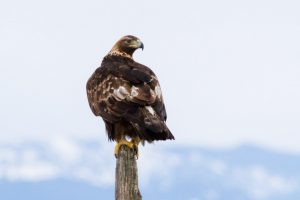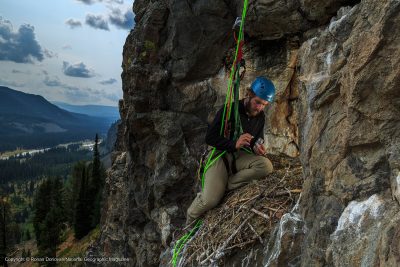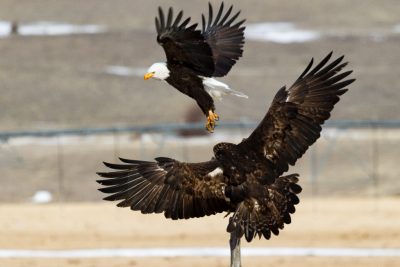This article first appeared in the Fall 2017 issue of Yellowstone Quarterly.
“Golden eagles are North America’s largest bird of prey, so why do we know so little about them?” asks Doug Smith, a senior wildlife biologist at Yellowstone National Park. To answer this question, Smith heads up the Yellowstone Golden Eagle Study, a scientific examination that monitors the population, breeding, and behavior of these magnificent birds in the park.
 This investigation is an outgrowth of the five-year Yellowstone Raptor Initiative, which began in 2011 with a grant from the Yellowstone Park Foundation and focused on studying the more than 20 species of raptors that call the park home. “Before the Yellowstone Park Foundation funded our initial study, the park was only monitoring three raptor species—peregrine falcons, bald eagles, and ospreys,” notes Smith. “After five years of research, we concluded there was a scientific oversight in terms of understanding golden eagle ecology, and determined there should be long-term monitoring of the species given the critical role they play in the functioning of an avian ecosystem.”
This investigation is an outgrowth of the five-year Yellowstone Raptor Initiative, which began in 2011 with a grant from the Yellowstone Park Foundation and focused on studying the more than 20 species of raptors that call the park home. “Before the Yellowstone Park Foundation funded our initial study, the park was only monitoring three raptor species—peregrine falcons, bald eagles, and ospreys,” notes Smith. “After five years of research, we concluded there was a scientific oversight in terms of understanding golden eagle ecology, and determined there should be long-term monitoring of the species given the critical role they play in the functioning of an avian ecosystem.”
Contributing to this need for further study is a 2016 U.S. Fish and Wildlife Service study that denoted the golden eagle population as “stable,” but also observed: “the population in the coterminous western U.S. [from the 100th meridian to the Pacific Ocean] might be declining towards a lower equilibrium size.”
There are many factors that could be contributing to the birds’ population decline, with everything from habitat loss, lead poisoning from scavenging on hunters’ kills, and high-speed wind turbines placed in ideal eagle environments playing a role. With such a large area to cover, some places have reported that the birds are doing well, and others have found cause for concern.

Researcher preparing to place a remote camera in an empty golden eagle nest.
The folks in Yellowstone realized that they had little data to contribute to the conversation. “When we discovered U.S. Fish and Wildlife was trying to determine the status of golden eagles throughout the West, we found out we knew little or no information about the birds in the Greater Yellowstone Ecosystem,” Smith says. “We thought we better learn more.” Enter Yellowstone Forever. Since the Yellowstone Park Foundation already sponsored the previous raptor study, Yellowstone Forever was poised to fund a continuation of the project. “Though the first go-round was a tremendous success, at the conclusion of the initial five years we knew there were still a lot of questions to be answered, especially about the golden eagles and the significant role they play in the ecosystem,” says Jeff Augustin, Yellowstone Forever’s senior director of park projects. “That’s why,” Augustin adds, “when it was over and the park submitted a list of the projects for funding that they deemed priorities, we were excited to see the golden eagle study on there.” Soon after, Yellowstone Forever secured gifts from individuals and foundations to fully fund the program for three years.
Smith classifies this extra time to study golden eagles as a “godsend.” That’s because so far the park’s monitoring has turned up some thought-provoking data that needs to be looked at closer. Thanks to the previous years of field work, which included countless miles of hiking in the backcountry to spot the birds and track them to their nests, researchers now know that Yellowstone is home to 28 golden eagle territories, each of which corresponds to a nested pair. (Golden eagles are very territorial and will dive bomb interlopers to defend their home range.) Twenty-one of these nesting areas are in the northern part of the park where the habitat—semi-open country, high-altitude mountains, and cliffsides—is more suitable to the birds.
According to Smith, what’s interesting about the golden eagles in Yellowstone is that their numbers and breeding habits don’t match up—the birds’ population density is quite high, but their productivity when it comes to producing offspring is very low. “We are focused right now on trying to figure why the eagles are doing so well but also why there are so few young.” Adding to the intrigue is that other studies have shown that golden eagles in the Livingston and Cody areas produce a lot of young.

A golden eagle fends off a bald eagle from a deer carcass – in Paradise Valley north of the park.
Smith is exploring two key factors as to whether or not young golden eagles survive: the severity of winter weather and the levels of spring precipitation. It is possible that heavy snow years mean more winter kills and more wolf kills, which in turn creates an abundance of food for eagles to scavenge and allows the birds to build up strength for the upcoming breeding season. But a cold and wet spring could cause problems with nesting, resulting in young that fail to survive.
“To study how the weather affects these birds we really need to see a variation of conditions for an extended time so that we can overlay the breeding and meteorological data for accurate results,” Smith says. “That’s why Yellowstone Forever continuing to fund this study is so important—the more years we study, the more reliable our findings will be.” Along with determining whether or not Yellowstone is a stronghold for these raptors, Smith believes the study will help place the golden eagle in the same conversation with Yellowstone’s most famous fauna—bears, bison, and wolves.
“These birds are grand, majestic animals. We’ve found 10–12 species of animals in golden eagles’ nests, everything from rabbits to pronghorn fawns. Golden eagles are every bit the predator as Yellowstone’s big carnivores,” Smith says. “They are the wolves of the sky and are deserving of the attention we and the public have given to Yellowstone’s other iconic wildlife.”
Comments are closed.